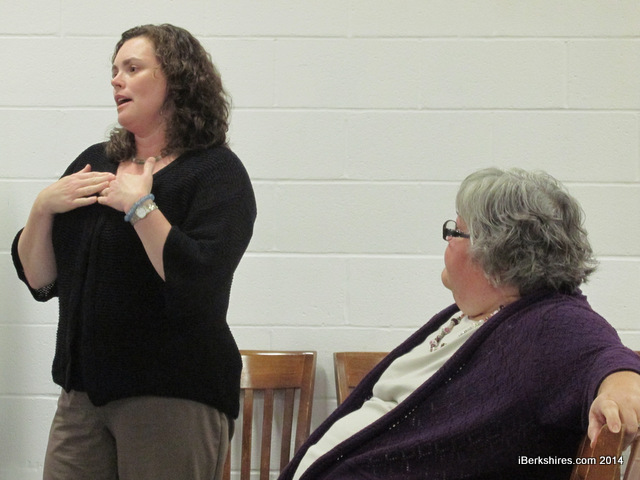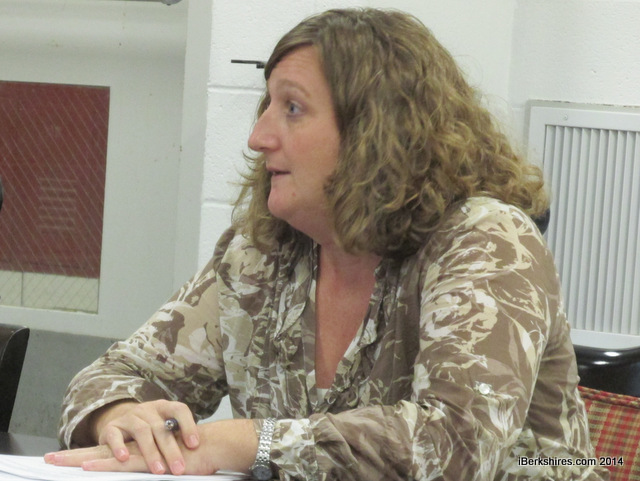 Lanesborough parent Tammy Seaman, right, looks on as Williamstown parent Margaret McComish asks the School Committee to revisit the late bus issue. Lanesborough parent Tammy Seaman, right, looks on as Williamstown parent Margaret McComish asks the School Committee to revisit the late bus issue. |
WILLIAMSTOWN, Mass. — The Mount Greylock Regional School Committee on Tuesday heard from parents concerned about the district's decision to cut down on the number of late buses for students participating in after-school activities.
More than a dozen residents attended the committee's regular monthly meeting, and five who identified themselves as parents of Mount Greylock students rose to ask the panel to reconsider the decision.
Committee members sympathized with parents, explaining that the late bus was a difficult but necessary cost cut in the face of opposition to the district's proposed budget last spring and that efforts are under way to find alternative funding to return some of the service.
Beginning this fall, Mount Greylock cut back to one late bus run, at 4:15, with one bus going to each of the district's member towns, Williamstown and Lanesborough. In the past, the school has offered as many as three late buses, in the 4 o'clock, 5 o'clock and 6 o'clock hours.
Since the opening of school, the unexpected retirement of a part-time teacher freed up some money in the budget that has allowed the school to offer a 5:15 bus with a split schedule, Principal Mary MacDonald said on Tuesday.
Currently, in addition to the two-town run at 4:15, Mount Greylock offers a 5:15 bus that goes to Williamstown on Mondays and Fridays and Lanesborough on Tuesday, Wednesday and Thursday, MacDonald said.
That still is insufficient, parents told the committee on Tuesday.
"There have been 27 accidents [on Route 7] between Williamstown and Lanesborough in the last three years," said Tammy Seaman, the mother of a Mount Greylock football player. "Three weeks ago, as you know, there was a fatality.
"I'm concerned as a taxpayer and as a parent to have young students driving our students around carpooling."
Some parents expressed concern that cutting back too one late bus will jeopardize participation rates in after-school activities.
"They say it takes a village to raise a child, well, it takes this school to raise those kids," Jeffrey Albert said. "It takes that school bus getting kids back and forth. A lot of parents have to tell their kids you can't play [sports] because I can't come get you."
MacDonald explained that when faced with the decision of choosing just one late bus, the administration opted for the 4:15 run because it serves high school students engaged in tutoring, makeup work and other academic projects, after-school clubs and middle school students whose athletic practices generally end earlier.
The school chose not to make that group wait for a 5:15 bus that would serve more varsity athletes because of the cost involved in supervising those students for an hour while they waited for the later bus and a desire to get the youngest students home as soon as possible.
"We would love to have a 5:15 bus going in both directions," MacDonald said. "But we're trying to look at safety and trying to prioritize what we are providing transportation for."
Seaman, a Lanesborough resident, said she began her conversation about the bus at Town Hall.
"I went to the town administrator, and he said I have to go to you folks," Seaman said. "He told me to my face not to go back to the town of Lanesborough to ask for any more money."
"Before we got to cutting buses, we did not replace positions," Superintendent Rose Ellis said. "We also cut professional development and technology. We held out as long as we could in terms of this particular investment.
"Your support is appreciated here tonight. ... When we bring the budget to the town, I'd love to see you come at that time as well."
School Committee member Robert Ericson attempted to use Tuesday's discussion to revisit an expenditure that he unsuccessfully sought to block at an Aug. 19 meeting. Ericson made a motion on Tuesday night to rescind the committee's
decision to hire a part-time clerk for $10,000 to help with the building project and apply that money to the late buses.
His motion was not seconded. Acting chairman David Langston said Ericson's motion was out of order and that the question needs to be considered by the School Committee's finance subcommittee first. Langston chaired the meeting in place of Chairwoman Carolyn Greene, who was ill.
Committee member Colleen Taylor told the parents in attendance she already had begun discussions to see whether funds raised by Mount Greylock's athletic booster clubs could be used to defray the cost of late buses. And MacDonald was receptive to a suggestion from a parent that the 5:15 bus — rather than going to one town two days a week and the other town three days a week — make a longer run to both towns each day.
MacDonald said there likely would be additional cost to such an arrangement but she would be happy to look into it.
Ericson said he favored that solution.
"I grew up in rural New York, and every day I spent 45 minutes on the bus going to school and 45 minutes coming home," he said. "It's not that big a hardship. I survived."
 Director of Pupil Personnel Services Kimberley Grady received a round of applause from the School Committee. Director of Pupil Personnel Services Kimberley Grady received a round of applause from the School Committee. |
Also on Tuesday night, the School Committee heard a report from the district's director of pupil personnel service.
Kimberley Grady told the committee that a recent coordinated program review by the state issued a report of "no findings" in the school's Special Education and English Language Learning programs.
"When I came here, we had 18 corrective actions for special education alone," Grady said. "In five years, the school has turned itself completely around."
Grady drew a round of applause from the committee and praise from Ellis.
"This is huge," Ellis said. "The coordinated program review, it haunts us year in and year out. As Kim said, five years ago, we were in deep trouble as far as our non-compliance."
MacDonald gave the committee an update on Mount Greylock's enrollment, based on the most current snapshot. The junior-senior high school has 561 students enrolled in all grades, down from 585 students on Oct. 1, 2013 (Oct. 1 is the official reporting date each year to the Massachusetts Department of Elementary and Secondary Education).
That represents a drop of just more than 4 percent. But MacDonald noted that the school has seen larger incoming classes the last two years. This year's seventh grade has 98 students; the eighth grade has 108. That compares with the current sophomore and junior classes, which have 87 and 82 students, respectively.
MacDonald said the "bubble" coming up to the high school will be a concern when the school budgets for faculty in the FY16 budget process, and the committee should anticipate a need for more teachers.
Langston said that the enrollment variation has hidden budget implications.
"The reason the budgets have been manageable during the [economic] downturn is that Mount Greylock's population had been declining," he said. "We get Chapter 70 [state funding] based on last year's population, not this year's population. When class sizes go up ... towns have to make up the difference.
"We cannot continue to coast on that artificial budget surplus."
In other business on Tuesday, Langston asked four other committee members present (Taylor, Ericson, Gary Fuls and Chris Dodig) if they had any comment on the Lanesborough Board of Selectmen's creation of an
ad hoc committee to study school affiliations for the town, but no one chose to say anything about it.
Among the charges to the Lanesborough committee: looking at whether the town should "shift out of Mount Greylock region and out of elementary School Union/District with Williamstown, go into Central Berkshire (possibly bringing Williamstown and Mount Greylock along)."